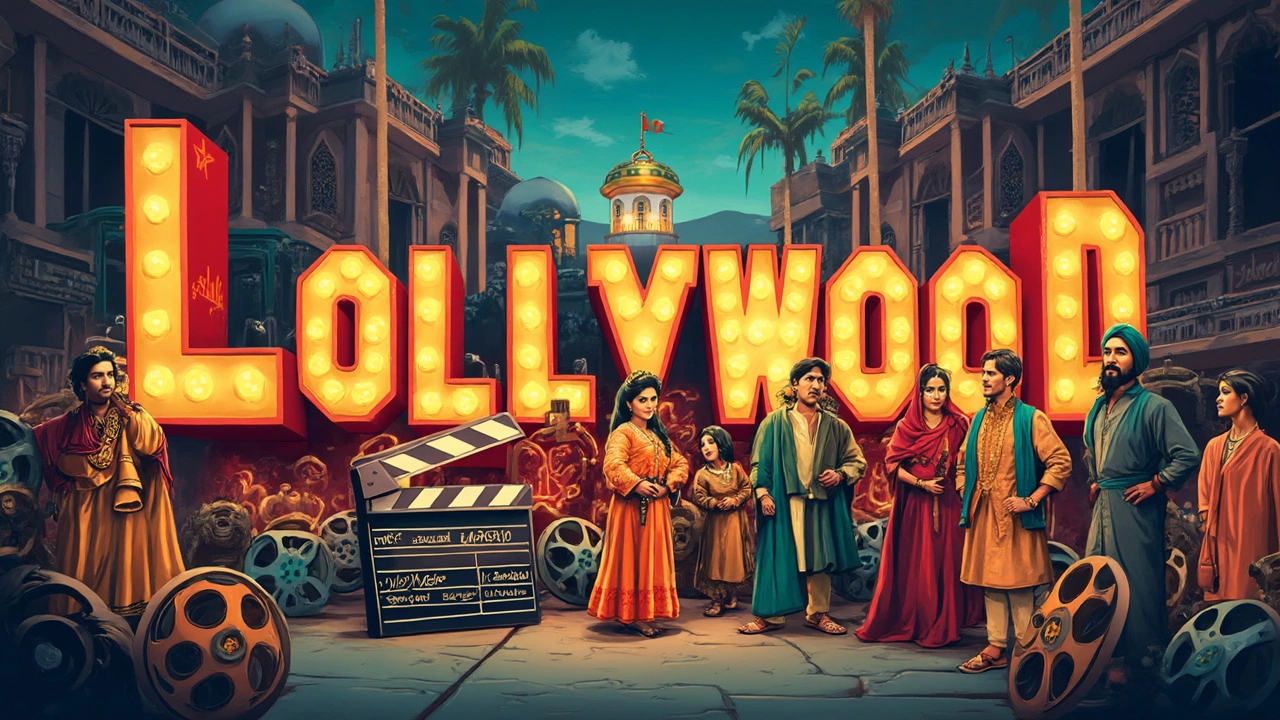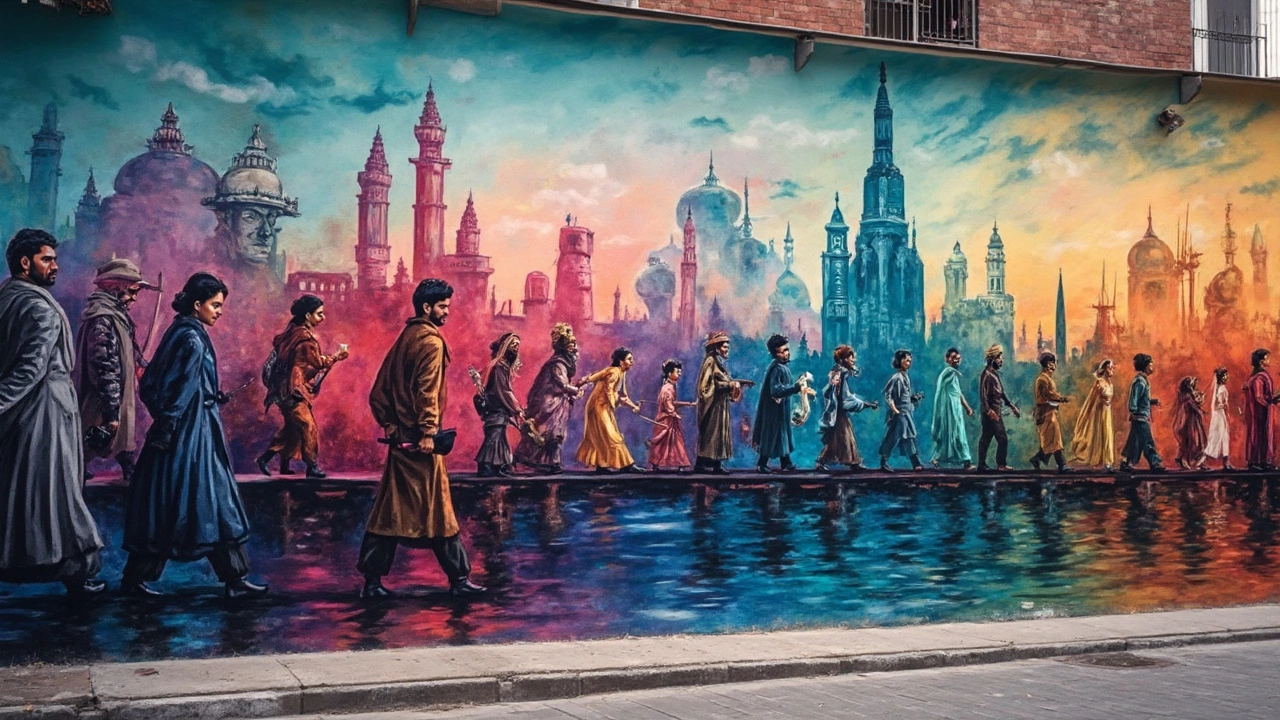Lollywood: The Story Behind Pakistan's Famous Film Industry Name
 Jun, 27 2025
Jun, 27 2025
Imagine you're flipping channels late at night, and you land on a movie bursting with colour, catchy tunes, and energetic dance numbers. You stick around for a bit, thinking, 'Bollywood?' But wait—something’s different. Then you spot the credits: 'Made in Lollywood.' Hold up, did you read that right? Yes, you did. Lollywood – a name that turns heads and sparks curiosity in film lovers across the world. It isn’t just a parody or a cheap knock-off of Bollywood’s blockbuster machine, but the epicentre of Pakistan’s movie magic. But where did that odd, almost playful name come from? Why is it called Lollywood and not something else entirely?
The Origins: A Portmanteau and a Playful Twist
Here’s something not many people know: Lollywood’s name isn’t as ancient as the industry itself. Pakistani cinema actually dates back to the 1920s, kicking off in Lahore, but this nickname only started making the rounds in the mid-1980s. Far from being some corporate branding brainstorm, the term 'Lollywood' originated from a blend of 'Lahore'—the city where the industry was born—and Hollywood, the global film mecca. This kind of playful word-blending actually started with Bollywood (Bombay + Hollywood), which then inspired film industries in various countries to do the same. But here’s the twist: many outside Pakistan think the name was coined ages ago, but it took until 1989 for journalist Saleem Nasir of the magazine 'Glamour' to actually use Lollywood in print for the first time.
Lahore wasn’t just the film capital in name only. For decades, the city’s famous Royal Park was packed with studios, and movie houses thrived along Abbott Road. Directors and scriptwriters would meet at Kashmiri Tea House, dreaming up legendary stories. Unlike Bollywood, which quickly grew into an all-consuming pan-Indian juggernaut, Lollywood kept its focus on Punjabi- and Urdu-language films. Early films carried the buzz of a new nation shaping its cultural identity—honestly, it wasn’t just about popcorn. The city’s cinemas could fill half a million seats at their peak. And before you think this was just local fun, Lahore’s movies made their way across the Pakistani diaspora—from London to Toronto—connecting generations of Pakistanis to their roots.
Now, why not Karachiwood or Islamabadwood? Simple—the heart of the industry was Lahore for nearly sixty years. Only in the 2000s did Karachi begin to nudge into the limelight, but the nickname stuck—by then, Lollywood had already become a pop culture statement. The city’s film set vibe also lent itself to the name: Lahore is famous for its wit, flair, and cheeky humour, so 'Lollywood' just fits in both spirit and sound. Even the studios embraced the name, putting it proudly on posters and banners. The global film industry might throw around dozens of -woods—Trollywood, Nollywood, Dhallywood—but Lollywood rolls off the tongue like it’s always belonged.
For anyone still drawing a blank at what makes Lollywood special, it boils down to its roots in Lahore, its originality, and a touch of self-aware fun. If you look at it from the perspective of those movie-makers in the pre-digital age, calling their industry 'Lollywood' was a sly wink to the world. It told everyone, 'Hey, we’ve got something unique going on here.' And that attitude shows in the energy of its classic films and the fandom they still inspire.

Lollywood Through the Decades: Hits, Struggles, and Revival
The birth of Lollywood was never just about the label—it was about life in Pakistan, played out on the big screen. The 1947 partition of India and Pakistan sent shockwaves through the region, and hundreds of artists and technicians moved between Bombay and Lahore. While Mumbai (then Bombay) emerged as Bollywood’s base, Lahore’s filmmakers carved their own path. In the 1950s and 1960s, Lahore’s cinema world produced films that are still considered classics—take 'Heer Ranjha' (1970) with its dreamy scenery and immortal soundtrack, or 'Armaan' (1966), the first Pakistani film to become a platinum jubilee hit. But the glamour also hid a side of relentless hustle and political pressures. During the era of military rulers in the 1970s and 1980s, strict censorship shaped scripts and storytelling.
So, what happened to Lollywood when the turbines of globalisation started spinning? For a while, things seemed stuck, or even slipping backwards. The advent of VCRs in the 1980s and the flood of pirated Indian movies into Pakistan dented ticket sales. Lucky Irani Circus-style melodramas replaced the carefully crafted scripts of previous decades. And then, by the 2000s, Karachi stepped onto the scene. The industry struggled, yes, but never died. There’s this popular myth that Lollywood just faded away, but the numbers tell a more complicated story. In 1977, Pakistan churned out more than 80 feature films in Urdu and Punjabi. By 2005, the count was barely a dozen.
But Pakistani cinema is nothing if not resilient. Around 2012, a fresh generation of directors, many of them trained abroad or in Karachi, blended new techniques into traditional storytelling. Movies like 'Waar' (2013) and 'Punjab Nahi Jaungi' (2017) pulled in huge crowds and showed that contemporary Lollywood had rediscovered what made Pakistani film tick in the first place. In 2024 alone, four Pakistani films crossed the Rs 100 crore mark at the box office—a first in the nation’s cinematic history (Lollywood fans finally had a reason to celebrate). Local actors like Mahira Khan, Fawad Khan, and Mehwish Hayat are now household names across South Asia, and streaming services like Netflix and Prime Video are starting to add Pakistani movies to their rosters.
Let’s throw in some real numbers and facts. Here’s a quick comparison between the eras:
| Year | Number of Films | City with Most Productions |
|---|---|---|
| 1965 | 61 | Lahore |
| 1977 | 87 | Lahore |
| 1990 | 34 | Lahore |
| 2005 | 12 | Karachi/Lahore mix |
| 2023 | 22 | Karachi |
So, the industry’s heart moved cities, the technology leapt forward, but that playful spirit signalled by 'Lollywood' kept the heart beating. Movie fans who grew up sneaking into dingy cinemas for a matinee show on Abbott Road, or watching films at home with family during Eid, still grab a ticket whenever a new Pakistani blockbuster lands. And now, music from Lollywood classics is being remixed by new Pakistani pop stars—proof that the name, just like the films, refuses to stay stuck in the past.

Lollywood in Pop Culture and Beyond
Names can be powerful. For Pakistani artists and fans alike, calling it 'Lollywood' means both owning their spot in the global film conversation and poking a bit of fun at the business of entertainment. The name has become shorthand for big weddings, over-the-top plots, and song breaks that lift the mood of even the most serious films. In Pakistan, you’ll hear people joking, 'Yeh scene tau bilkul Lollywood style hai!' when someone does something dramatic at a party. It’s a phrase woven into everyday language, not just a film term.
Did you know that Pakistan's first ever film, 'Teri Yaad,' was released in 1948, exactly one year after independence? Not many outside Pakistan have seen films like 'Aina' (1977) or 'Choorian' (1998), which both ran in cinemas for more than a year and turned unknown actors into superstars overnight. To this day, Lahore’s surviving picture houses screen these hits during Eid holidays—an old-school treat that’s stubbornly survived the Netflix age.
If you want to dive deeper than just the films, here are some tips:
- Visit the historic Shahi Mohallah district in Lahore, once packed with film studios and post-production houses. Even today, you can find walls covered in vintage hand-painted movie posters.
- Stream a few Lollywood classics online—many are now available on YouTube, and the original soundtracks are a playlist goldmine.
- Try spotting the 'Lollywood effect' in Pakistani wedding videos and commercials—those vibrant colours, dance sequences, and matching costumes didn’t just come from nowhere!
- Chat with any Lahori native about the city’s film history, and you’ll get stories passed down from parents and grandparents—about stars whose glamour changed fashion trends and set teenage hearts racing decades before Instagram influencers existed.
The label 'Lollywood' also finds its way into fashion, memes, and even food names. Just check out “Lollywood biryani” in some Karachi and Lahore restaurants and you’ll see what I mean. Internationally, it’s a source of pride—Pakistanis in Birmingham, London, or Toronto spot the same sense of shared humour and nostalgia at any 'Lollywood Night' event, where fans dress up as classic stars and belt out karaoke numbers to legendary tracks by Noor Jehan or Ahmed Rushdi.
A quirky piece of trivia: there’s even a chocolate brand called 'Lollywood' sold in Pakistan, complete with wrappers decorated in retro movie poster style. You won’t find that kind of branding for any of the other 'woods.' That sense of fun, of not taking things too seriously, is the real spirit behind the name. It’s a way of poking fun at stereotypes, but also of saying, 'this is ours.' And if a name can capture decades of drama, dance, heartbreak, and hope, Lollywood is a reminder that the best stories don’t just happen in Hollywood.